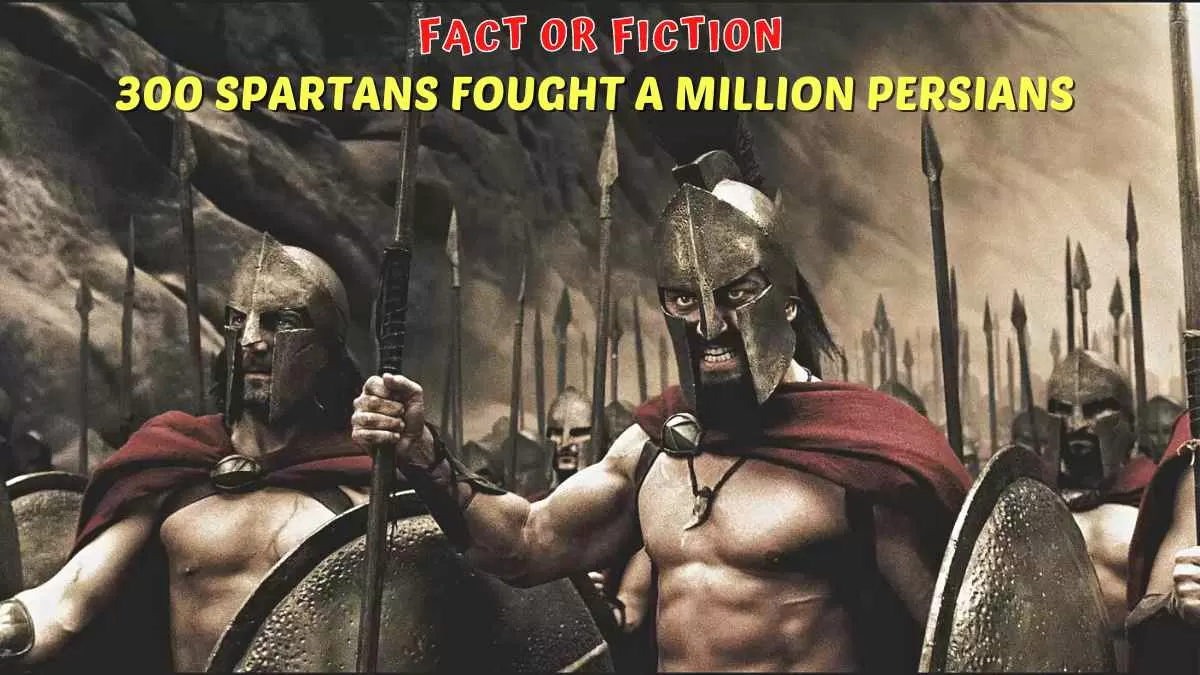The Battle of Thermopylae is one of the most famous last stands in history and is known for King Leonidas and 300 soldiers of Sparta fighting a million-strong Persian army. Read on to know if this popular legend is a fact or fiction.
 Fact or Fiction: 300 Spartans Fought A Million Persians In The Battle of Thermopylae
Fact or Fiction: 300 Spartans Fought A Million Persians In The Battle of Thermopylae
Fact or Fiction: The Battle of Thermopylae (480 BC) between Greeks and Persians is known for two things: an utter Greek defeat leading to the “Persian Destruction of Athens” and arguably the most famous last stand in history: 300 Spartan soldiers holding off an enormous Persian army.
The Battle of Thermopylae has become the stuff of legend ever since. The belief that Leonidas, the King of Sparta, commanded 300 of his fiercest and bravest soldiers into battle against what were supposedly millions of Persian invaders led by Xerxes I and nearly claimed victory is prevalent today, all thanks to numerous songs, poems, and blockbuster movies dedicated to the battle.
Some people even believe that the Spartans won the Battle of Thermopylae against the mighty and innumerable Persian army. But is there any truth to this legend? That’s what we’re here to find out today.
Dive in to know how many of the views surrounding the Battle of Thermopylae have a historical basis and if the belief that 300 Spartans fought millions of Persians is a fact or fiction.
300 Spartans vs A Million Persians?
You’d be surprised to know that the Battle of Thermopylae and Leonidas’s last stand are two of the most exaggerated events in history. Due to popular movies and graphic novels, the story of the 300 Spartans and their sacrifice has achieved near-mythical status.
Frank Miller’s 1998 comic book series 300 and its 2006 film adaptation directed by Zack Snyder are why most people even know about the Battle of Thermopylae.
However, it’s time to separate fact from fiction. But first, take a look at the brief history of Sparta and the events leading up to the Battle of Thermopylae.
History of Sparta
Sparta was a warrior society-state in ancient Greece that reached its zenith in the late fifth century BC after defeating Athens.
Spartan culture emphasised loyalty to the state and military service. The Spartans were known to be brave and fierce.
Boys in the state were taken from their mothers at a young age and forced to undergo rigorous military and educational training called the Agoge. This training prepared the boys for war and instilled values of discipline, hard work, and merit in them.
Spartan women did not participate in the Agoge but still enjoyed considerable rights compared to other states.
Sparta was at the forefront of the Greco-Persian Wars (499–449 BC) and, along with Athens, led the unified Greece to victory.
The Battle of Thermopylae

Source: Wikimedia Commons
The second invasion of Greece, led by Xerxes I, was launched in 480 BC. In August, Xerxes was due to reach Thermopylae, a narrow pass connecting the northern and southern parts of Greece.
So, King Leonidas departed with his personal bodyguard (Hippeis) of 300 soldiers. Most were hardened veterans with children to carry on their legacy.
Leonidas was joined by 700 Thespians, 1000 Phocians, 400 Thebans, and numerous Boeotians, Arcadians, and Lacedaemonians. The overall army commanded by Leonidas numbered around 7,000.
Leonidas’ plan was simple. Constrict the large Persian army into the narrow pass at Thermopylae and hold them for as long as possible to buy time for the allied Greek navy and armies to gather.
How many troops served in the Persian Army?
According to Herodotus, the Persian army numbered 2.6 million. Other historic records of the time also put them around the same number.
However, Ctesias counted 800,000 Persians, and modern estimates put the Persian Army between 120,000 and 300,000. Although the Persian army couldn’t have ranged in the millions due to logistical constraints of that era, they still outnumbered the Greeks nearly 100 to 1.
Hence, we’ve established that it wasn’t just 300 Spartans who defended Greece from the Persians. They had significant help. Also, the Persian army didn’t comprise millions of soldiers. However, they were still massive.
The Last Stand of King Leonidas
The Greeks inflicted heavy losses on the Persians for the first few days. The Greeks were following an excellent strategy, and there was only one flaw in their plan: an alternate path through the mountains around Thermopylae. Ephialates, a greedy Greek citizen, betrayed his countrymen for reward, and the Persians soon outflanked the Greeks.
King Leonidas ordered his troops to retreat, but he stayed behind. It was against the Spartan code to surrender or retreat. The 300 Spartans who refused to leave were accompanied by 700 Thespians, 400 Thebans, and likely the helots, slaves of the Spartans. Leonidas and all the Spartans perished. The body of Leonidas was decapitated, and any surviving Greeks were branded as slaves.
Summing Up
There are a lot of myths surrounding the Spartans due to their representation in popular culture. No, they didn’t storm into battle with just a helmet and cloak, highlighting their bare chests and bulging muscles. As brave and heroic as they were, the Spartans were still humans. Leonidas and his 300 soldiers put up a valiant last stand, but the Battle of Thermopylae was an absolute failure for the Greeks.
King Leonidas saved more than half of this army and bought some time, but he did nothing to budge the giant Persian army, much less defeat them. And although the Persians were huge in number, they didn’t measure in millions. Hence, it’s a fiction that 300 soldiers alone fought millions of Persians in the Battle of Thermopylae.
News
Reacher Season 3’s Narrowed Release Window Reportedly Revealed
SUMMARY Reacher season 3 could be released in early 2025. Sticking to a yearly release schedule could help Reacher grow its audience. This is especially true since Reacher has consistently high viewership similar to broadcast TV procedural hits. The release window for Reacher season 3 has…
Reacher season 3 premiere date: A tiny new tease
While there may not be a formal Reacher season 3 premiere date yet at Prime Video, there is something more that we can share! Previously, star Alan Ritchson had shared on Instagram that the action drama would not be back until 2025,…
Nicolas Cage Is ‘Terrified’ of AI and Got Digitally Scanned for Spider-Man Noir: ‘I Don’t Want You to Do Anything’ With My Face and Body ‘When I’m Dead’
Nicolas Cage said in an interview for The New Yorker that he is terrified of AI and is hoping recent body scans he had to do for two upcoming projects aren’t used as reference for AI technology to recreate him on screen after…
Reacher season 3 premiere date: The worst-case scenario?
We know that Reacher season 3 is coming at some point to Prime Video. Not only that, but filming is already done! A great deal of the groundwork has already been laid regarding the show’s future, and there is now just a…
Gods Of Egypt’s Casting Controversy Explained
SUMMARY Whitewashing of Egyptian gods with white actors led to a negative impact on Gods of Egypt. Lack of diversity in casting choices resulted in backlash, poor reviews, and financial failure. Movie’s failure at the box office emphasized the importance…
Gerard Butler disses ‘Free Guy’, Ryan Reynolds generously responds
Ryan Reynolds has offered a response to comments from Gerard Butler about his latest feature, ‘Free Guy’, and his other movies. Earlier this month, the ‘300’ star gave an interview to Unilad promoting it, and he included some scathing comments about Ryan Reynolds’ work….
End of content
No more pages to load











